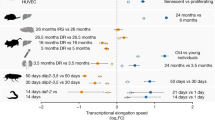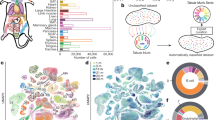Abstract
The nematode Caenorhabditis elegans is an important model for studying the genetics of ageing, with over 50 life-extension mutations known so far. However, little is known about the pathobiology of ageing in this species, limiting attempts to connect genotype with senescent phenotype. Using ultrastructural analysis and visualization of specific cell types with green fluorescent protein, we examined cell integrity in different tissues as the animal ages. We report remarkable preservation of the nervous system, even in advanced old age, in contrast to a gradual, progressive deterioration of muscle, resembling human sarcopenia. The age-1(hx546) mutation, which extends lifespan by 60–100%, delayed some, but not all, cellular biomarkers of ageing. Strikingly, we found strong evidence that stochastic as well as genetic factors are significant in C. elegans ageing, with extensive variability both among same-age animals and between cells of the same type within individuals.
This is a preview of subscription content, access via your institution
Access options
Subscribe to this journal
Receive 51 print issues and online access
We are sorry, but there is no personal subscription option available for your country.
Buy this article
- Purchase on SpringerLink
- Instant access to full article PDF
Prices may be subject to local taxes which are calculated during checkout




Similar content being viewed by others
References
Vanfleteren, J. R. & Braeckman, B. P. Mechanisms of life span determination in Caenorhabditis elegans. Neurobiol. Aging 20, 487–502 (1999)
Braeckman, B. P., Houthoofd, K. & Vanfleteren, J. R. Insulin-like signaling, metabolism, stress resistance and aging in Caenorhabditis elegans. Mech. Ageing Dev. 122, 673–693 (2001)
Lithgow, G. J. & Walker, G. A. Stress resistance as a determinate of C. elegans lifespan. Mech. Ageing Dev. 123, 765–771 (2002)
Sulston, J. E. & Horvitz, H. R. Post embryonic cell lineages of the nematode Caenorhabditis elegans. Dev. Biol. 56, 110–156 (1977)
White, J. G., Southgate, E., Thomson, J. N. & Brenner, S. The structure of the nervous system of Caenorhabditis elegans. Phil. Trans. R. Soc. Lond. B 314, 1–340 (1986)
Klass, M. R. Aging in the nematode Caenorhabditis elegans: major biological and environmental factors influencing life span. Mech. Ageing Dev. 6, 413–429 (1977)
Bolanowski, M. A., Jacobson, L. A. & Russell, R. L. Quantitative measures of aging in the nematode Caenorhabditis elegans. II. Lysosomal hydrolases as markers of senescence. Mech. Ageing Dev. 21, 295–319 (1983)
Driscoll, M. Cell death in C. elegans: Molecular insights into mechanisms conserved between nematodes and mammals. Brain Pathol. 6, 411–425 (1996)
Johnson, T. E. Aging can be genetically dissected into component processes using long-lived lines of Caenorhabditis elegans. Proc. Natl Acad. Sci. USA 84, 3777–3781 (1987)
Hall, D. H. et al. Neuropathology of degenerative cell death in C. elegans. J. Neurosci. 17, 1033–1045 (1997)
Maduro, M. & Pilgrim, D. Identification and cloning of unc-119, a gene expressed in the Caenorhabditis elegans nervous system. Genetics 141, 977–988 (1995)
Mitani, S., Du, H., Hall, D. H., Driscoll, M. & Chalfie, M. Combinatorial control of touch receptor neuron expression in Caenorhabditis elegans. Development 119, 773–783 (1993)
Colavita, A., Krishna, S., Zheng, H., Padgett, R. W. & Culotti, J. G. Pioneer axon guidance by UNC-129, a C. elegans TGF-β. Science 281, 706–709 (1998)
Apfeld, J. & Kenyon, C. Regulation of lifespan by sensory perception in Caenorhabditis elegans. Nature 402, 804–809 (1999)
Perkins, L. A., Hedgecock, E. M., Thomson, J. N. & Culotti, J. G. Mutant sensory cilia in the nematode Caenorhabditis elegans. Dev. Biol. 117, 456–487 (1986)
Campagnola, P. J. et al. Three-dimensional high-resolution second-harmonic generation imaging of endogenous structural proteins in biological tissues. Biophys. J. 82, 493–508 (2002)
Epstein, J., Himmelhoch, S. & Gershon, D. Studies on ageing in nematodes. III. Electron microscopical studies on age-associated cellular damage. Mech. Ageing Dev. 1, 245–255 (1972)
Hall, D. H. et al. Ultrastructural features of the adult hermaphrodite gonad of Caenorhabditis elegans: relations between the germ line and soma. Dev. Biol. 212, 101–123 (1999)
Kimura, K. D., Tissenbaum, H. A., Liu, Y. & Ruvkun, G. daf-2, an insulin receptor-like gene that regulates longevity and diapause in Caenorhabditis elegans. Science 277, 942–946 (1997)
Friedman, D. B. & Johnson, T. E. A mutation in the age-1 gene in Caenorhabditis elegans lengthens life and reduces hermaphrodite fertility. Genetics 118, 75–86 (1988)
Duhon, S. A. & Johnson, T. E. Movement as an index of vitality: comparing wild type and the age-1 mutant of Caenorhabditis elegans. J. Gerontol. A Biol. Sci. Med. Sci. 50, B254–B261 (1995)
Bolanowski, M. A., Russell, R. L. & Jacobson, L. A. Quantitative measures of aging in the nematode Caenorhabditis elegans. I. Population and longitudinal studies of two behavioral parameters. Mech. Ageing Dev. 15, 279–295 (1981)
Kirkwood, T. B. Evolution of ageing. Nature 270, 301–304 (1977)
Kirkwood, T. B. Human senescence. BioEssays 18, 1009–1016 (1996)
Kirkwood, T. B. Changing complexity in aging: a metric not an hypothesis. Neurobiol. Aging 23, 21–22 (2002)
Johnson, T. E. et al. Relationship between increased longevity and stress resistance as assessed through gerontogene mutations in Caenorhabditis elegans. Exp. Gerontol. 36, 1609–1617 (2001)
Finch, C. E. & Kirkwood, T. B. L. Chance, Development, and Aging (Oxford Univ. Press, New York, 2000)
Sozou, P. D. & Kirkwood, T. B. A stochastic model of cell replicative senescence based on telomere shortening, oxidative stress, and somatic mutations in nuclear and mitochondrial DNA. J. Theor. Biol. 213, 573–586 (2001)
Kirkwood, T. B. Evolution of ageing. Mech. Ageing Dev. 123, 737–745 (2002)
Leonard, D. S., Bowman, V. D., Ready, D. F. & Pak, W. L. Degeneration of photoreceptors in rhodopsin mutants of Drosophila. J. Neurobiol. 23, 605–626 (1992)
Helfand, S. L. & Naprta, B. The expression of a reporter protein, β-galactosidase, is preserved during maturation and aging in some cells of the adult Drosophila melanogaster. Mech. Dev. 55, 45–51 (1996)
Morrison, J. H. & Hof, P. R. Life and death of neurons in the aging brain. Science 278, 412–419 (1997)
Jucker, M., Bondolfi, L., Calhoun, M. E., Long, J. M. & Ingram, D. K. Structural brain aging in inbred mice: potential for genetic linkage. Exp. Gerontol. 35, 1383–1388 (2000)
Waterston, R. H. The Nematode: Caenorhabditis elegans (ed. Wood, W. B.) 281–337 (Cold Spring Harbor Laboratory Press, Cold Spring Harbor, NY, 1988)
Hughes, S. M. & Schiaffino, S. Control of muscle fibre size: a crucial factor in ageing. Acta Physiol. Scand. 167, 307–312 (1999)
Fujisawa, K. Some observations on the skeletal musculature of aged rats. Part 2. Fine morphology of diseased muscle fibres. J. Neurol. Sci. 24, 447–469 (1975)
Takahashi, A., Philpott, D. E. & Miquel, J. Electron microscope studies on aging Drosophila melanogaster. 3. Flight muscle. J. Gerontol. 25, 222–228 (1970)
Arantes-Oliveira, N., Apfeld, J., Dillin, A. & Kenyon, C. Regulation of life-span by germ-line stem cells in Caenorhabditis elegans. Science 295, 502–505 (2002)
Garigan, D. et al. Genetic analysis of tissue aging in Caenorhabditis elegans. A role for heat-shock factor and bacterial proliferation. Genetics 161, 1101–1112 (2002)
Wolkow, C. A., Kimura, K. D., Lee, M. S. & Ruvkun, G. Regulation of C. elegans life-span by insulin like signaling in the nervous system. Science 290, 147–150 (2000)
Hsin, H. & Kenyon, C. Signals from the reproductive system regulate the lifespan of C. elegans. Nature 399, 362–366 (1999)
Lund, J. et al. Global profiles of aging in Caenorhabditis elegans. Curr. Biol. 12, 1566–1573 (2002)
Johnson, T. E. & McCaffrey, G. Programmed aging or error catastrophe? An examination by two-dimensional polyacrylamide gel electrophoresis. Mech. Ageing Dev. 30, 285–297 (1985)
Rogina, B., Vaupel, J. W., Partridge, L. & Helfand, S. L. Regulation of gene expression is preserved in aging Drosophila melanogaster. Curr. Biol. 8, 475–478 (1998)
Lewis, J. A. & Fleming, J. T. Caenorhabditis elegans: Modern Biological Analysis of an Organism (eds Epstein, H. F. & Shakes, D. C.) 4–27 (Academic, San Diego, 1995)
Hall, D. H. Electron microscopy and three-dimensional image reconstruction. Methods Cell Biol. 48, 395–436 (1995)
Paupard, M. C., Miller, A., Grant, B., Hirsh, D. & Hall, D. H. Immuno-EM localization of GFP-tagged yolk proteins in C. elegans using microwave fixation. J. Histochem. Cytochem. 49, 949–956 (2001)
Hedgecock, E. M., Culotti, J. G., Thomson, J. N. & Perkins, L. A. Axonal guidance mutants of Caenorhabditis elegans identified by filling sensory neurons with fluorescein dyes. Dev. Biol. 111, 158–170 (1985)
Acknowledgements
We thank the following people for providing the following strains used in this study: B. Wadsworth for IM175, S. Clark for ZB154, R. Padgett for NW1099, A. Fire for PD4251, P. Hoppe and B. Waterston for RW1596, B. Grant for DH1033, I. Johnstone for IA019, E. Jorgensen for EG1653, and J. Plenefisch for rhIs2. We also thank the Caenorhabditis Genetics Center funded by NIH NCRR for the TJ1052 and BE13 strains. We thank G. Stephney, T. Stephney and K. Nguyen for help with electron microscopy; B. Levine and A. Melendez for helpful discussions about autophagy in C. elegans; G. Patterson and B. Grant for critical reading of this manuscript; and T. Johnson and D. Wu for advice about the analysis of behavioural class as a predictor of life expectancy. This work was supported by grants from the National Institute of Neurological Disorders and Stroke and the National Institute on Aging to M.D., and the Center for C. elegans Anatomy was supported by a grant from the NIH Division of Research Resources to D.H.
Author information
Authors and Affiliations
Corresponding authors
Ethics declarations
Competing interests
The authors declare that they have no competing financial interests.
Supplementary information
Rights and permissions
About this article
Cite this article
Herndon, L., Schmeissner, P., Dudaronek, J. et al. Stochastic and genetic factors influence tissue-specific decline in ageing C. elegans. Nature 419, 808–814 (2002). https://doi.org/10.1038/nature01135
Received:
Accepted:
Issue Date:
DOI: https://doi.org/10.1038/nature01135
This article is cited by
-
Tissue-specific profiling of age-dependent miRNAomic changes in Caenorhabditis elegans
Nature Communications (2024)
-
Automated recognition and analysis of body bending behavior in C. elegans
BMC Bioinformatics (2023)
-
C. elegans ageing is accelerated by a self-destructive reproductive programme
Nature Communications (2023)
-
Early life changes in histone landscape protect against age-associated amyloid toxicities through HSF-1-dependent regulation of lipid metabolism
Nature Aging (2023)
-
_targeting the “hallmarks of aging” to slow aging and treat age-related disease: fact or fiction?
Molecular Psychiatry (2023)



